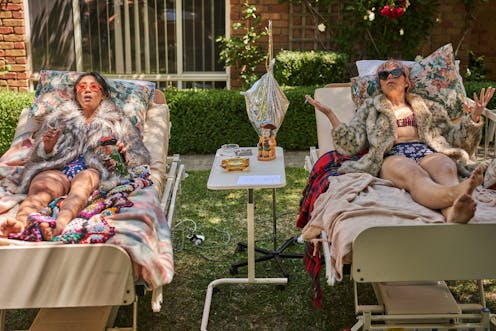A Beginner’s Guide to Grief: joy and sadness belong together in this new Australian ‘traumedy’
- Written by Sian Mitchell, Lecturer, Film, Television and Animation, Deakin University

Review: A Beginner’s Guide to Grief, directed by Renée Mao
We all experience grief in different ways. It is a powerful force that can affect our daily lives, making the simplest task feel difficult, at best, or entirely insurmountable at worst.
Grief is messy, surprising, revealing and honest at different times and all at once.
This is what lies at the heart of the SBS comedy A Beginner’s Guide to Grief.
Written by its star, Anna Lindner, and directed by Renée Mao, the six 12-minute episodes follow Harriet “Harry” Wylde as she navigates her way through the five stages of grief (denial, anger, bargaining, depression and acceptance also provide the first five episode titles) after losing both her parents to cancer within a week – first her mum and then her dad on the day of her mum’s funeral.
Aunty Barb (Georgina Naidu) is the epitome of “putting on a brave face” as she attempts to offer Harry solace in the knowledge that at least her dad is “now in the arms of our Lord and Saviour”.
Harry’s very Christian Uncle Trev (Rory Walker) and creepy cousin Isaiah (Carlo Ritchie) take over her dad’s funeral preparations with the implication that men can deal with these kinds of emotional situations better.
The most interesting relationship in the series is between Harry and her foster-sister Daisy (Cassandra Sorrell), a pyromaniac who has spent time in prison after lighting a car on fire when she was young.
Their relationship is far from perfect, but Daisy is a welcome relief from the rest of the family’s suffocating presence.
Read more: Iggy & Ace: a zany Aussie comedy about two gay best friends — and alcohol abuse
Contemporary traumedies
A Beginner’s Guide to Grief joins recent series like Netflix’s Never Have I Ever (2020-) and After Life (2019-2022) that centre on grieving characters who have lost loved ones and are left behind to cope in the aftermath.
These shows have been labelled “traumedies”: narratives that explore feelings of loss and pain presented through a comedic lens.
Traumedies can offer audiences an opportunity for catharsis, processing our feelings of loss and grief – particularly at a time of so much social and cultural upheaval.
Like these international examples, A Beginner’s Guide to Grief invites us to have frank conversations about and acknowledge the impacts of death, dying and grieving openly – rather than bottling those feelings away to maintain an image of strength.
It is through the series’ funniest thread, a self-help audio tape on dealing with grief that Harry listens to each episode, we truly feel permission to laugh at tragedy.
The tape’s grief therapist, brilliantly voiced by Ted Lasso’s Brett Goldstein, provides a bizarre distraction for Harry – and us – as each stage of grief is described in more and more ridiculous ways. Grief, the tape tells us, is:
an overwhelming emotion not unlike […] sitting down to your favourite breakfast cereal but then pouring its milky sweet contents over your lap, smashing the porcelain bowl with nothing but your forehead, and slowly swallowing shard after jagged shard of the broken remains until you realise you are indeed bleeding from your stomach.
A visceral yet poetic description.
Read more: The five stages of grief don't come in fixed steps – everyone feels differently
Grief is a mixed bag
The sixth and final episode, The Next Chapter, initially feels unnecessary. We have moved through the five stages of grief, after all. But Lindner is careful to acknowledge grief is not cured once you’ve reached “acceptance”.
The process of grieving is complex and can’t be miraculously solved by the end of a series.
Life must go on for Harry, but she still has some healing to do.
Throughout the series, flashbacks are interwoven with the present-day, depicting scenes of happier times with her parents next to ones showing the realities and ravages of cancer.
The show is semi-autobiographical. Lindner’s father died from cancer, and her mother was also diagnosed with the disease. She brings a deep perspective on her own grief. “I want people to know that grief and joy don’t just co-exist, but they belong together,” she has said.
A Beginner’s Guide to Grief does not offer a particularly unique perspective on grief, but it is a worthy local entry into the traumedy genre and an excellent example of contemporary Australian short form storytelling.
A Beginner’s Guide to Grief premieres on SBS On Demand on September 4.
Authors: Sian Mitchell, Lecturer, Film, Television and Animation, Deakin University





